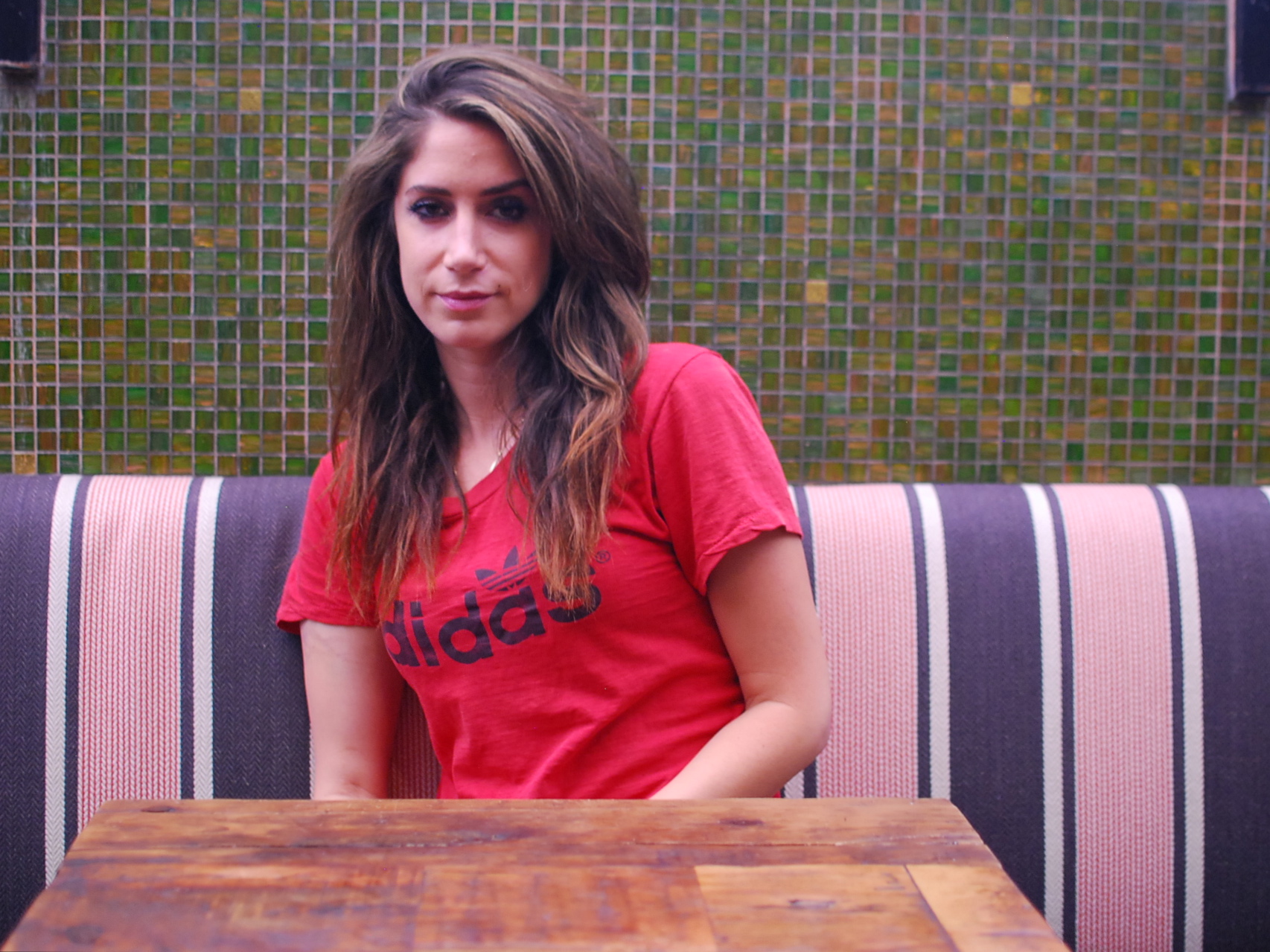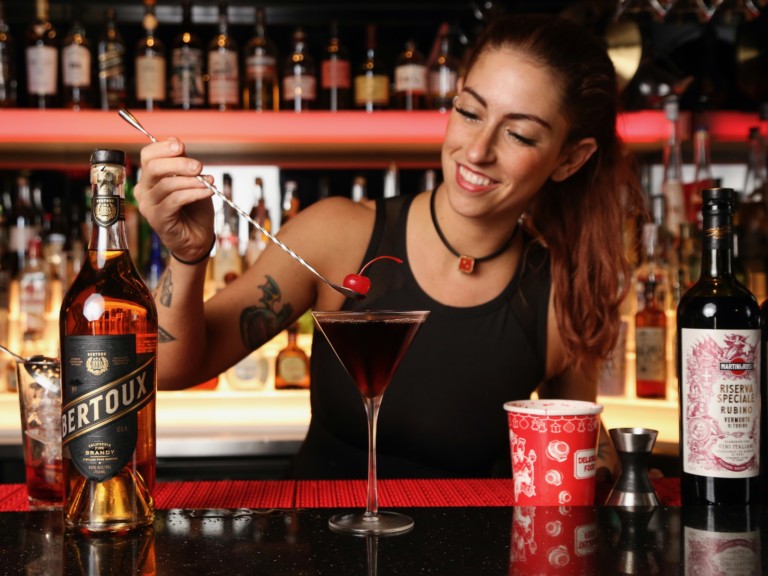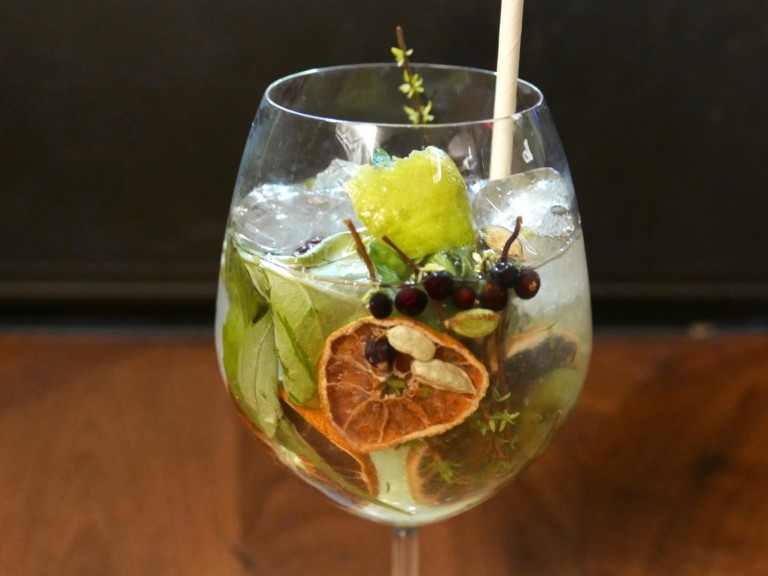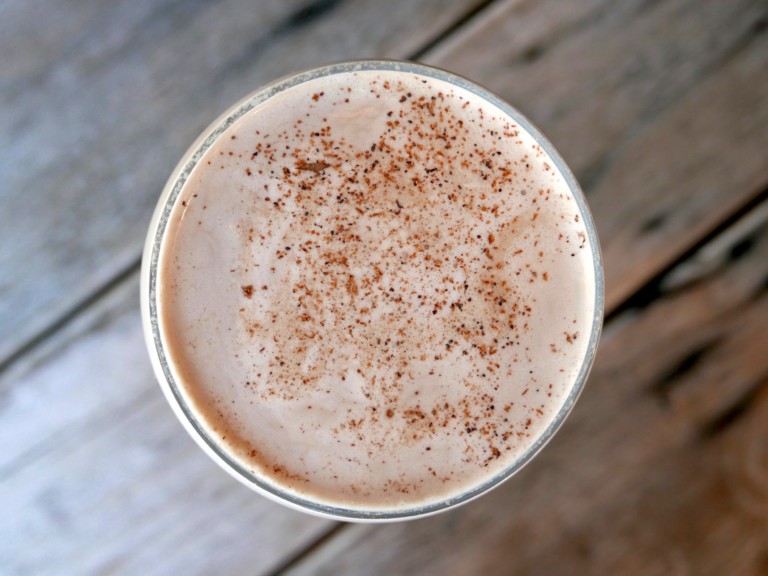Venice Beach native Kate Grutman gained an appreciation for cocktails and bartending during her days managing The Doheny, when an all-star crew of Vincenzo Marianella, Marcos Tello and Eric Alperin anchored 213’s bygone private bar. She gained a strong base in Italian spirits at Mozza and Terroni, rounded out her knowledge base at The Tar Pit, and currently works as bar manager of Sotto, which is where she discussed her background, influences and approach.
What did you major in at UC Berkeley?
Art, painting, and French.
Do you feel like either one of those helps you in what you do now?
French, no, not so much, but painting and art, totally. It sounds sort of hokey to say, but I always sort of feel like part of the process of – pardon the expression – mixology if you will – is so creative. It gets to the point where you study it for a long time, you educate yourself on your spirits and your ingredients and your amari and your products, the more that you work with it – the longer that I’ve worked with it – the more I sort of feel like the craft part of mixology, sort of the culinary aspect, does remind me a lot of painting in that I feel like it’s using colors.
So cocktails can be art?
Absolutely…If you start with your basic cocktail family, and your basic spirits, it’s like your primary colors, you learn how to use those colors, and you start expanding your knowledge to other colors, to secondary colors, to secondary spirits, to cordials, to liqueurs, to amari, and you learn how to work with those. Then you keep expanding. It’s like painting. You learn how to use all the products like you would with colors, how to mix them to achieve a result, how to accent and heighten the flavor of the spice in rye with the bitter sweetness of Cynar in a Manhattan variation instead of doing just sweet vermouth and bitters and rye. It’s a super creative process in my opinion, very much so like painting, if you will.
Had you worked much with amari before?
I first started working with amari at Mozza, when I was studying wine, and when the Osteria opened, they had this insane amaro collection. I would kind of go over there and after my shift at the Pizzeria and try all the amari. I was absolutely fascinated by the mystery of them, because you don’t know what’s in them. They’re all these guarded family recipes that were originally created for medicinal purposes in terms of either being a digestivo or aperitivo or Fernet, soothing to the stomach. I was just fascinated by them, not knowing what’s in them, not having any real definition of ingredients for them. Averna was Mario Batali’s favorite thing ever. Every time he was in town, it was just Averna everywhere. Averna became this tradition; every night, everyone does shots of Averna.
Then I went to Terroni, and there were tons of amari there as well. Again, very Italian clientele, so I got to use those a lot. It’s not so much cocktails at Terroni as it is just base spirits, and then everyone wants a grappa or amaro. I just fell in love with it because I had been bartending around traditional spirits at The Tar Pit, and really learned how to use them at The Tar Pit. Then just continued to be fascinating. There’s just an endless array of them, and each one is just – they’re just amazing and mysterious to me – and they accent different things. Sometimes you taste the rhubarb in one of them if you mix it with bourbon, but you don’t taste it at all if you put it with gin. It’s a very elusive, sexy thing to me.
What’s a recent example of an amaro cocktail you made, and what was your approach?
The first amaro inspired cocktail that blew my mind, and I fell in love with, was when I was at The Tar Pit, the Little Italy, which I learned from Chad Solomon. I believe it’s one of Audrey’s drinks. It’s like a Manhattan variation. There were all these Manhattan variations, the Little Italy, Red Hook, the Green Point, for example. The Little Italy, which is Cynar, Carpano Antica sweet vermouth or whatever sweet vermouth you want to use, and rye, just blew my mind. It was a Manhattan, but in the most exquisite, herbaceous way.
I hadn’t heard of that one before. I’ve had the Red Hook and Green Point.
They’re all so different. They’re all structurally Manhattan variations, and they’re all – in terms of having the elements sweet, bitter and spirit – and it’s fun because those are the first three off the beaten path amari based cocktails that I learned when I was at The Tar Pit. Chad was a big proponent of those, especially being from New York.
Would you say that you have any mentors?
Absolutely. 100%. I feel super lucky for my experience. It kind of reminds me of when I was acting, when I was younger, and going to all these different schools, and having all these different teachers. Each one had a different method, if you will, or a different school of thought. Stella Adler, Meisner, Lee Strasberg, whatever. Moving around, I kept pulling what worked from each teacher, or each class, and then using what I learned myself to achieve the desired result.
My first exposure to mixology, if you will, was at The Doheny. I was managing with Aidan Demarest. We opened that with Vincenzo Marianella, Eric Alperin and Marcos Tello. I was just in heaven, because it was being in the middle of three powerhouse, super creative mixologists and it was sort of in its birth downtown, so that was three, four years ago. They each worked so differently and had such different inspirations. Eric was Sasha Petraske school, Milk & Honey, very classic cocktails, executed with total perfectionism and complete accuracy, classically.
Then you have Vincenzo, who had this strong London background and was kind of doing all these off the beaten path – like the Smoke of Scotland, one example – this is insane. I had no idea.
Then there’s Marcos, and Marcos was so much of a teacher as well because Marcos was hands on, let’s do spirits training, let’s talk and talk and talk, and it was an incredible experience. It wasn’t very busy for the first three hours of the night because it was this private bar, so I would just sit and taste spirits and learn. With Marcos, one thing that jumped out about him is that he’s just so passionate about talking about, and educating, so I just fell in love with it…
I went through all the training at The Tar Pit, with Audrey and Chad and Christy, and Marcos, essentially, as well, who was so humble through the process, because it was like, well, despite everything I already know, I’m in the presence of these great, just awe inspiring bartenders who don’t even really use the word mixologist. I just sat there every day and listened to Chad and Audrey…
Chad really sort of recognized how passionate I was about it, so he allowed me to participate in all the training, and he sort of took me under his wing…He questioned everything I ever thought I knew, humbled me to the core, literally every time I thought I knew something about a brand or I thought I had arrived, and knew all these cocktails and read all these books, he was like, “Let me ask you, why would you mix it in that proportion?” He’s so brilliant, and is just an encyclopedia, and would sit with me and just pontificate and intellectualize it and challenge me…
Chad left to go back to New York, and one thing he said to me, “If there’s one person I’d like you to work with who I feel will continue to enhance your knowledge and will be working with good habits, and operating how I would want you to operate, it would be Julian Cox.” It’s interesting, because Julian got trained by Sammy Ross, and Chad and Sammy Ross came from the same schools, but went separate ways. If you look at their recipes and specs, they’re very different…One day Julian called me up and said, “Hey, would you be interested in opening Playa? Then I think you’d be great for Sotto.” And I was like, “Fuck, yeah.”
I’ve learned so much from Julian in terms of – he’s just meticulous, his cleanliness, his passion, his flavor, everything, I’ve just learned so much, and re-learned different recipes that I already knew, but with his specs. So it was very cool to see those differences, and also a very humbling experience.
And Audrey was such a fabulous role model too because she’s just tough as nails. She was so hard on me at first. She doesn’t generally hire women that much, and she was just always with the boys, and she’s tough, and I loved it. I just thought this woman is completely just a powerhouse, and fun, and I loved it.
What was your first bar job?









Leave a Comment